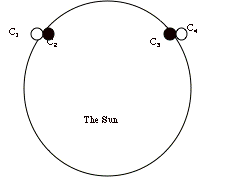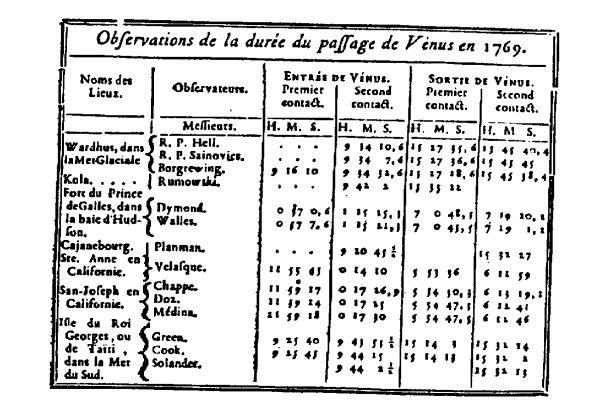

The Venus Transit 2004
... Educational Sheet 3
Appendix 5
Calculation of Δβ by measuring
the duration of the transit
(this approach is more like the current method where students will record the contact times and send them to the Transit of Venus website)
We assume that the apparent motion takes place at a constant velocity which is the same for all observers. This is not a bad approximation as the velocity depends on the relative motion of Venus and the Earth round the Sun and on the rotation of the Earth on its own axis. (The speed depends on the latitude of the observer too, but this is neglected in order to simplify the process).
Therefore instead of measuring a distance, we measure the duration of the transit.
If t A and t B are the durations of the transits A 1 2 and B 1 B 2 , and we introduce t 0 as the hypothetical duration of a transit along a diameter, we can write
A 1 2 / t A = B 1 B 2 / t B = D / t 0
Then the time relation t' / t 0 corresponding to A'B' / D in the previous formula for the chords is
t' / t 0 = 0.5 [√(1 - (t B / t 0 ) 2 ) - √(1 - (t A / t 0 ) 2 )]
Be careful which contact times you use in your calculations. Note that there are external and internal contact times. Only the internal ones can be measured well.
The contact times of Venus with the Sun are used to calculate the duration of the transits: t A and t B are the times of internal contact C 2 and C 3 because they are better determined than the others.
We use the results C 2 and C 3 of Vardö and Tahiti for this calculation.
For Vardö (location A with observer Borgrewing) we calculate from the previous table
t A = 15h 27m 28.6s - 9h 34m 32.6s = 21176 s
For Tahiti (location B with observer Cook) we calculate t B = 15h 14m 11s - 9h 44m 15s = 19796 s
Using the relationship A 1 2 / t A = B 1 B 2 / t B = D / t 0 we can get t 0. Of course there are two possibilities t 0 consider. We select the observation made in Vardö by Borgrewing because it looks more precise. Then using the measurements made on line 1 and the diameter of the drawing, B 1 B 2 = 49 mm (line 1) and D = 70 mm,
49 /19796 = 70 / t 0
So we obtain t 0 = 28506 s
t' / t 0 = 0.5 [√(1 - (19796 / 28506) 2 ) - √(1 - (21176 / 28506) 2 )] = 0.02505
and Δβ is given by
Δβ = (π / 360) 0.02505 = 0.00027 radians
Repeating the same process as before, using the parallax formula and the solar parallax relationship, we have
r e = AB / (0.38248 Δβ)
Using the data from the 1769 expeditions and AB = 11425 km we can calculate
r e = 144 10 6 km which is reasonably close t 0 the currently accepted value considering the assumptions that have been made.
Back to the Appendix 4
Back to the EduSheet 3


